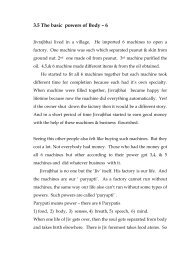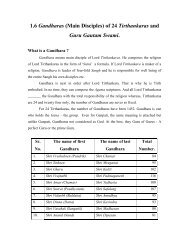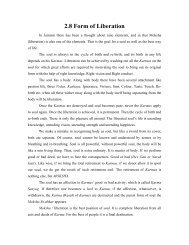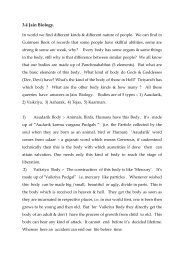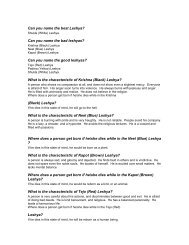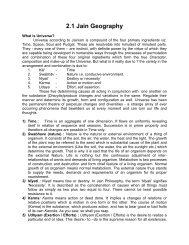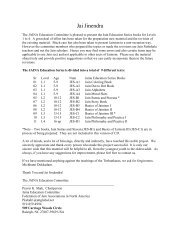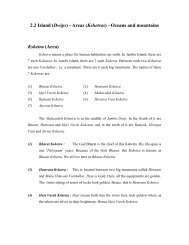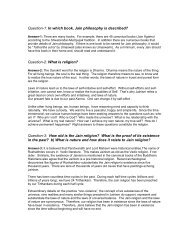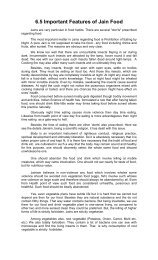Paryushan Parva - Jainism, Jain Religion - colleges
Paryushan Parva - Jainism, Jain Religion - colleges
Paryushan Parva - Jainism, Jain Religion - colleges
You also want an ePaper? Increase the reach of your titles
YUMPU automatically turns print PDFs into web optimized ePapers that Google loves.
Sämäyik in English with Meaning<br />
State of Equanimity<br />
PHASE I – TAKING VOWS FOR SÄMÄYIK<br />
(Sämäyik and Pratikraman are performed in the presence of the right guru, or his/her presence is<br />
assumed by installing a religious book that has Navakär Mahämantra and Panchidiya Sutra on a<br />
seat with Navakärväli on top of it. The aspirant sits in front of the preceptor’s seat facing East or<br />
North.)<br />
(By reciting the following short Sutra, the aspirant pays homage to the<br />
preceptor by first standing with his/her Charavalä in his/her folded hands<br />
and then by kneeling down having his/her feet, knees, elbows, forehead and<br />
folded hands touch the floor.) (Three times)<br />
Khamäsamanä Sutra (Homage to the Preceptor):<br />
Original Sutra<br />
Ichchämi Khamäsamano,<br />
Vandium Jävanijjäe;<br />
Niseehiäe,<br />
Matthaena Vandämi.<br />
Meaning<br />
Oh! Forgiving Gurudev, I am giving up all my<br />
wrongful acts with all my strength and bow down<br />
to you with my head near to your feet.<br />
(Now, the aspirant sits down on his/her katäsanä)<br />
(Holding Muhapatti in the left hand and extending the right palm towards<br />
the preceptor’s seat, the aspirant should recite the following Navakär<br />
Mahämantra and Panchindiya Sutra)<br />
Original Sutra<br />
Namo Arihantänam<br />
Namo Siddhänam<br />
Namo Äyariyänam<br />
Namo Uvajjhäyänam<br />
Lesson 1 - Obeisance to Five Supremes (Navakär Mahämantra)<br />
Meaning<br />
I bow down to Arihants 13 ; I bow down to<br />
Siddhäs 14 ; I bow down to Ächäryäs; I bow down<br />
to Upädhyäys; I bow down to the universal<br />
fraternity of Sädhus and Sädhvies. This fivefold<br />
13 The term Arihant is made up of Ari, meaning enemies, and hant, meaning destroyer. Consequently, Arihant means<br />
destroyer of all internal enemies such as anger, greed, ego, and deceit. Once a soul has shed all of its four defiling<br />
(ghäti) karma namely Jnänavarniya (Knowledge obscuring) Karma, Darshanävarniya (Perception obscuring) karma,<br />
Mohniya (Deluding) Karma and Antaräya (Obstructive) Karma, and who had earned Tirthankar Näm Karma in his/her<br />
previous third life becomes a Tirthankar. He/she is also called Tirthankar. These Tirthankars reinstate the <strong>Jain</strong> Sangh<br />
(four-fold <strong>Jain</strong> Order) consisting of Sädhus (monks), Sädhvis (nuns), Shrävaks (male householders), and Shrävikäs<br />
(female householders).<br />
14 Siddhäs are liberated souls. They have reached the highest state, salvation, and have attained Moksha. They have<br />
eradicated all their karma, and therefore do not accumulate any more new karma, thus freeing themselves forever from<br />
the cycle of birth and death (Akshaya Sthiti). They are experiencing ultimate, unobstructed bliss (Abädhya Sukh) and are<br />
not subjected to any kind of suffering. They possess perfect and total knowledge (Anatjnäna, Kevaljnäna, omniscience)<br />
and perception (Anat Darshan, Kevaldarshana, omni-perception), that means they know and perceive everything in<br />
total that is happening now, that has happened in the past, and that which will happen in the future all at the same time,<br />
and they also possess infinite vigor (Anant-Virya). They have no desires and are completely detached thus making them<br />
immune from any sense of craving or aversion (Anant Chäritra, Viträgatva). Despite the fact that all Siddhäs retain a<br />
unique identity, they are equal (Aguru-laghutva) and formless (Arupitva).<br />
8




